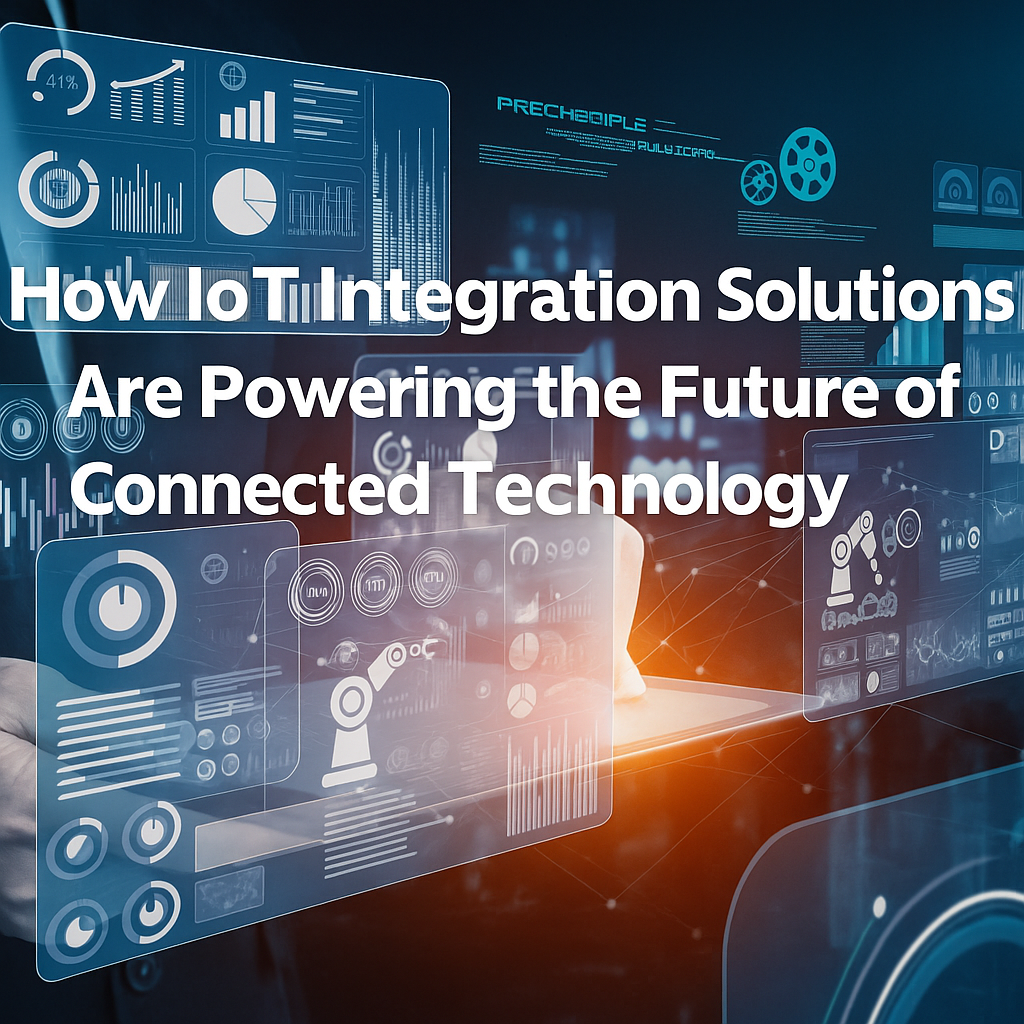In the fast-evolving world today, the Internet of Things (IoT) is a shifting tide that is transforming industries, businesses, and everyday lives. IoT devices are transforming the way information is collected and shared, from smart homes and networked cars to factory robots and healthcare. But the real potential of IoT is not so much in the devices themselves but in how they are brought together—how information moves seamlessly across sensors, platforms, and analytics systems. That is where IoT integration solutions enter the scene.
These solutions make IoT devices talk to each other, systems stay in sync, and meaningful insights are extracted from gathered data. In this article, we discuss what IoT integration solutions are, why they matter, most significant advantages, applications across industries, and the trouble that businesses have to set them up.
What Are IoT Integration Solutions?
IoT integration solutions are platforms, tools, and solutions intended for unifying diverse IoT devices, enterprise applications, and data sources into a single system. IoT integration solutions enable companies to capture, manage, and analyze data coming from multiple devices in a manner that all parts of an IoT network interact effectively and securely.
That is, IoT integration connects internet-of-things devices with business systems such as ERP, CRM, and analytics dashboards—enabling decision-making in real-time.
Why IoT Integration Solutions Are Required
IoT devices create mountains of data every single second. In the absence of integration, data goes into silos, with few potential gains. IoT integration solutions bring all systems—hardware, software, and cloud—into harmony.
Here’s why they are important:
Data Unification
Integration solutions consolidate data from various IoT sensors onto a single platform, ensuring easier access and analysis.
Real-Time Insights:
IoT devices can be connected to analytics platforms such that businesses can view operations in real time and make quicker data-driven decisions.
Increased Efficiency:
Automated processes powered by IoT minimize human intervention, thus saving time and reducing errors.
Scalability:
As businesses expand, IoT integration platforms enable seamless integration of additional devices without impacting the current system.
Better Security:
Advanced integration solutions have encryption and authentication layers as part of their functionality to assist in data privacy and integrity.
Main Components of IoT Integration Solutions
You should learn about the primary components used prior to discovering how IoT integration operates:
Device Connectivity Layer:
Links the IoT devices using protocols like MQTT, HTTP, or CoAP to transmit information to gateways or cloud.
Data Management Platform:
Processes and stores data from connected devices and collects it.
APIs and Middleware:
Application Programming Interfaces (APIs) serve as intermediaries between IoT devices and enterprise applications, making communication smooth.
Cloud Integration:
IoT platforms predominantly use cloud infrastructure for remote access, scalability, and analytics.
Analytics and Visualization Tools:
The tools transform raw data from IoT into actionable insights using reporting systems, AI models, and dashboards.
Industries Using IoT Integration Solutions
IoT integration is no longer the domain of technology companies—it’s changing industries across the world. Amongst the large industries benefiting from such innovations are:
1. Manufacturing (Industry 4.0)
Manufacturing units employ IoT integration to link devices, track production lines, and anticipate maintenance requirements. This minimizes downtime, maximizes efficiency, and aids automation.
2. Healthcare
Healthcare employs IoT integration to link patient monitors, wearable sensors, and hospital networks. This optimizes health monitoring and enhances response times.
3. Smart Cities
Smart city initiatives largely rely on IoT integration to link traffic systems, waste systems, street lighting, and public safety networks to optimize overall urban efficiency.
4. Agriculture
IoT-integrated sensors enable farmers to monitor soil health, weather, and crop condition, facilitating data-based farming and optimal utilization of resources.
5. Energy and Utilities
IoT integration in smart grids helps monitor energy consumption, predictive maintenance, and enhance sustainability.
Benefits of IoT Integration Solutions
Companies who use IoT integration have some benefits such as:
Seamless Connectivity: Integrate various devices and applications into a single system.
Operational Transparency: Offers end-to-end visibility into operations, which translates to quicker problem-solving.
Cost Reduction: Predictive analysis and automation save on maintenance and operational expenses.
Improved Customer Experience: Facilitates personalization and anticipatory support across integrated products.
Innovation Enablement: Assists businesses in creating wiser, more responsive products and services.
Challenges of IoT Integration
Although it has advantages, IoT integration is challenging:
Data Security:
Preventing sensitive information from the IoT environment from being vulnerable to cyber attacks is a cause for concern.
Device Compatibility:
The use of various communication protocols by various IoT devices makes them hard to integrate.
Scalability Issues
Massive networks of devices need robust and agile infrastructure to manage.
Cost and Complexity:
Creation and upkeep of an integrated IoT environment may prove costly.
Data Overload:
Significant amounts of data from IoT need sophisticated analytics and storage facilities.
Future of IoT Integration Solutions
The future of IoT deployment is bright, with the driver now emanating from AI, 5G, and edge computing innovations. AI-driven analytics will create IoT data more relevant, with 5G networks providing much faster and superior connectivity. Edge computing will also enable faster processing by bringing the computation nearer to the data sources.
Before long, IoT integration platforms will be more accessible than ever, with low-code and no-code development environments making it possible for businesses of any size to create connected systems without requiring advanced technical knowledge.
Conclusion
As more and more companies embrace digital transformation, IoT Embedded Systems are the epicenter of this transformation. They facilitate seamless connectivity, real-time data exchange, and wiser decision-making—fostering advancement in various industries. From manufacturing automation, through healthcare monitoring, to smart city management, integrated IoT ecosystems are building the future of innovation.
Organizations investing in secure and scalable IoT integration platforms today are laying the groundwork for a more connected, efficient, and data-driven tomorrow.
FAQs
Q1. What are IoT integration solutions?
IoT integration solutions are the systems and platforms that integrate different IoT devices and apps to exchange information and communicate seamlessly over networks.
Q2. Why is IoT integration important?
It enables organizations to integrate data, be more efficient, and extract actionable intelligence from networked devices, resulting in improved decision-making.
Q3. Which industries employ IoT integration?
Manufacturing, healthcare, farming, smart cities, and energy are a few of the industries which extensively employ IoT integration for automating and analyzing data.
Q4. What are the problems of IoT integration?
Some of the problems are data security, compatibility with devices, exorbitantly high prices, and dealing with large datasets.
Q5. How does AI improve IoT integration solutions?
AI facilitates quicker analysis of IoT data, predictive maintenance requirements, and automated decision-making to realize intelligent system performance.




Leave a Reply